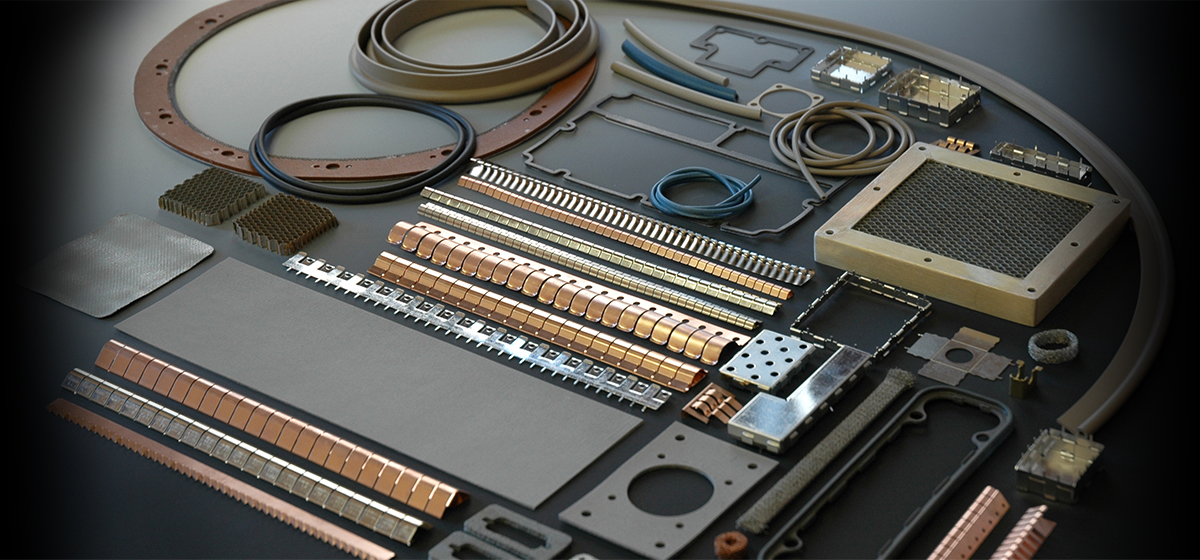How To Prevent Corrosion from Affecting Fabric Shielding Gaskets?

All metals face the problem of corrosion. They react either electrochemically or chemically with the environment to form a compound that is stable in the environment. The design process for fabric shielding gaskets needs to take the environment under consideration if corrosion is to be prevented. A minimum finish is required to stop chemical corrosion and create an electrically conductive surface for the common metals used in construction.
The designers must understand that the most common form of corrosion facing EMI gaskets is galvanic corrosion. For this to occur, some specific conditions need to exist – two metals capable of producing a voltage between them, electrically connected by a current path, and doused in a fluid that can dissolve the less noble of the two. Basically, the conditions of a battery need to exist. Once these conditions are met, current flows and corrosion occurs to a certain extent, based directly on the total quantity of current produced by the galvanic cell. When a fabric shielding gasket is placed between two metal flanges, the first parameter is usually met as the flanges are probably not made of the same metal used in the construction of the gasket. Most flanges are composed of steel or aluminum while the EMI shielding gaskets contain tin, silver, monel or other metals. The second condition is satisfied by the innate conductive properties of the fabric shielding gasket. The final condition may be realized when the gasket is placed in service, where atmospheric humidity, if allowed to collect on the surface of the gasket, may provide the electrolyte for the ion solution.
Many fabric shielding gasket users prefer using monel wire-filled materials or monel mash as they are apparently resistant to the effects of corrosion. The truth is that these substances do not oxidize with time even when moisture is present in the environment. However, in terms of the electrochemical compatibility with aluminum flanges, monel is highly active and the use of the alloy necessitates a careful edge sealing and flange finish treatments to actually avoid galvanic corrosion.
One common myth is that every silver-bearing elastomer behaves galvanically like silver. However, experiments conducted to exhibit the galvanic impact of silver-filled elastomers gaskets in aluminum flanges prove otherwise. The outcome showed that the degree of corrosion was a lot less than expected. In fact, aluminum-filled silver-plated elastomers exhibited minimum galvanic corrosion while the copper-filled silver-plated elastomers exhibited more.
Sealing the flanges with conductive silver-bearing elastomers is not the most effective method of limiting corrosion. In fact, corrosion control presents several problems whether the fabric shielding gasket remains tin-plated, monel wire-filled, or silver-filled. It is the responsibility of the designer to consider the factors that facilitate galvanic activity and then ensure the safety levels. This does not, however, guarantee complete protection against corrosion. It only limits the corrosion to the exterior edges of the flange after prolonged exposure to humid environments. However, to increase the effectiveness, due attention must be paid to the finishes and the flange materials used in the gaskets. The objective must be corrosion control within acceptable limits. Controlling the corrosion process in flanges sealed with fabric shielding gaskets is possible with the right design of the gasket and the flange, along with the proper choice of the gasket material. A good design necessitates a moisture-sealing EMI gasket whose shape, compression, thickness, and deflection characteristics permit it to fill every gap resulting from surface irregularities and uneven flanges ranging from tolerance buildups and fasteners. The correct design and application will help prevent the impact of moisture and inhibit corrosion on the inside of the gasket and the flange faces.
The problem of corrosion is a common one. The design process for fabric shielding gaskets is important as corrosion resistance is imparted to the products at that stage via the construction materials. A good finish is necessary. Resolving the corrosion issue will allow gaskets to perform better against electromagnetic interference.
